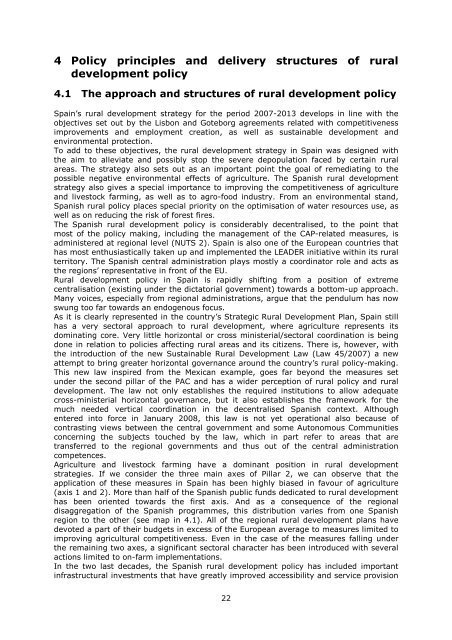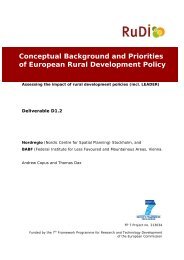Country profile on rural characteristics Spain - RuDI
Country profile on rural characteristics Spain - RuDI
Country profile on rural characteristics Spain - RuDI
- No tags were found...
You also want an ePaper? Increase the reach of your titles
YUMPU automatically turns print PDFs into web optimized ePapers that Google loves.
4 Policy principles and delivery structures of <strong>rural</strong>development policy4.1 The approach and structures of <strong>rural</strong> development policy<strong>Spain</strong>’s <strong>rural</strong> development strategy for the period 2007-2013 develops in line with theobjectives set out by the Lisb<strong>on</strong> and Goteborg agreements related with competitivenessimprovements and employment creati<strong>on</strong>, as well as sustainable development andenvir<strong>on</strong>mental protecti<strong>on</strong>.To add to these objectives, the <strong>rural</strong> development strategy in <strong>Spain</strong> was designed withthe aim to alleviate and possibly stop the severe depopulati<strong>on</strong> faced by certain <strong>rural</strong>areas. The strategy also sets out as an important point the goal of remediating to thepossible negative envir<strong>on</strong>mental effects of agriculture. The Spanish <strong>rural</strong> developmentstrategy also gives a special importance to improving the competitiveness of agricultureand livestock farming, as well as to agro-food industry. From an envir<strong>on</strong>mental stand,Spanish <strong>rural</strong> policy places special priority <strong>on</strong> the optimisati<strong>on</strong> of water resources use, aswell as <strong>on</strong> reducing the risk of forest fires.The Spanish <strong>rural</strong> development policy is c<strong>on</strong>siderably decentralised, to the point thatmost of the policy making, including the management of the CAP-related measures, isadministered at regi<strong>on</strong>al level (NUTS 2). <strong>Spain</strong> is also <strong>on</strong>e of the European countries thathas most enthusiastically taken up and implemented the LEADER initiative within its <strong>rural</strong>territory. The Spanish central administrati<strong>on</strong> plays mostly a coordinator role and acts asthe regi<strong>on</strong>s’ representative in fr<strong>on</strong>t of the EU.Rural development policy in <strong>Spain</strong> is rapidly shifting from a positi<strong>on</strong> of extremecentralisati<strong>on</strong> (existing under the dictatorial government) towards a bottom-up approach.Many voices, especially from regi<strong>on</strong>al administrati<strong>on</strong>s, argue that the pendulum has nowswung too far towards an endogenous focus.As it is clearly represented in the country’s Strategic Rural Development Plan, <strong>Spain</strong> stillhas a very sectoral approach to <strong>rural</strong> development, where agriculture represents itsdominating core. Very little horiz<strong>on</strong>tal or cross ministerial/sectoral coordinati<strong>on</strong> is beingd<strong>on</strong>e in relati<strong>on</strong> to policies affecting <strong>rural</strong> areas and its citizens. There is, however, withthe introducti<strong>on</strong> of the new Sustainable Rural Development Law (Law 45/2007) a newattempt to bring greater horiz<strong>on</strong>tal governance around the country’s <strong>rural</strong> policy-making.This new law inspired from the Mexican example, goes far bey<strong>on</strong>d the measures setunder the sec<strong>on</strong>d pillar of the PAC and has a wider percepti<strong>on</strong> of <strong>rural</strong> policy and <strong>rural</strong>development. The law not <strong>on</strong>ly establishes the required instituti<strong>on</strong>s to allow adequatecross-ministerial horiz<strong>on</strong>tal governance, but it also establishes the framework for themuch needed vertical coordinati<strong>on</strong> in the decentralised Spanish c<strong>on</strong>text. Althoughentered into force in January 2008, this law is not yet operati<strong>on</strong>al also because ofc<strong>on</strong>trasting views between the central government and some Aut<strong>on</strong>omous Communitiesc<strong>on</strong>cerning the subjects touched by the law, which in part refer to areas that aretransferred to the regi<strong>on</strong>al governments and thus out of the central administrati<strong>on</strong>competences.Agriculture and livestock farming have a dominant positi<strong>on</strong> in <strong>rural</strong> developmentstrategies. If we c<strong>on</strong>sider the three main axes of Pillar 2, we can observe that theapplicati<strong>on</strong> of these measures in <strong>Spain</strong> has been highly biased in favour of agriculture(axis 1 and 2). More than half of the Spanish public funds dedicated to <strong>rural</strong> developmenthas been oriented towards the first axis. And as a c<strong>on</strong>sequence of the regi<strong>on</strong>aldisaggregati<strong>on</strong> of the Spanish programmes, this distributi<strong>on</strong> varies from <strong>on</strong>e Spanishregi<strong>on</strong> to the other (see map in 4.1). All of the regi<strong>on</strong>al <strong>rural</strong> development plans havedevoted a part of their budgets in excess of the European average to measures limited toimproving agricultural competitiveness. Even in the case of the measures falling underthe remaining two axes, a significant sectoral character has been introduced with severalacti<strong>on</strong>s limited to <strong>on</strong>-farm implementati<strong>on</strong>s.In the two last decades, the Spanish <strong>rural</strong> development policy has included importantinfrastructural investments that have greatly improved accessibility and service provisi<strong>on</strong>22



